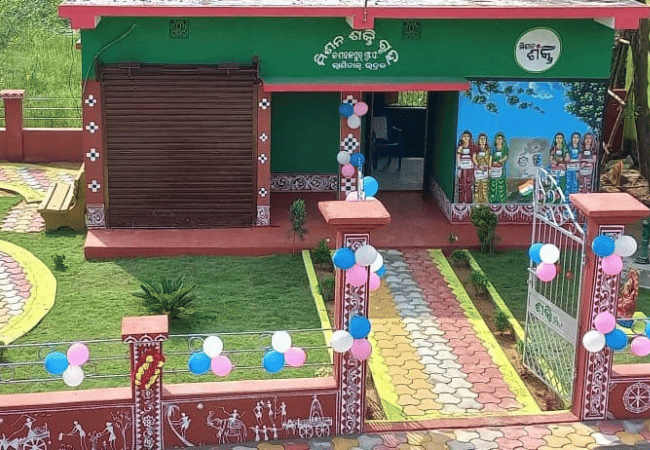From Margin to Mainstream: Mission Shakti’s Audacious Journey for Women in Odisha
Pragyan Rath
May 07, 2024. 4 minute Read
If you are new to the state, ride through it; you will be amazed at how women run Mission Shakti cafes and handloom businesses in various bus stands across the state. You can even ask women from lower middle-class backgrounds and various deep pockets of Odisha how mission Shakti has changed their lives and how well these schemes are.
Take a moment now!
Throughout history, women have been the unsung heroes of determination and development in the heartlands of Odisha, where the sounds of rural life reverberate across lush, green surroundings.
However, their voices and capabilities should have been more frequently addressed.
Aiming to change women’s lives in Odisha, the State Government recognized this gap. It created the ground-breaking Mission Shakti Yojana, which was inaugurated on 8 March 2001 by the Hon’ble Chief Minister of Odisha, Sri Naveen Patnaik.
As a comprehensive effort to bring women from the margins into the mainstream of societal advancement, Mission Shakti focuses on reducing the gender gap, promoting economic empowerment, solving health and sanitation issues, and boosting education.
"
In this article addresses we will address the significant influence of the Mission Shakti Yojana in Odisha and how it has become a force for change, bringing women from the margins to the forefront of social advancement.
Mission Shakti: A Rising Force in Odisha
With women making up 49.5% of the state’s population, the government of Odisha launched the “Mission Shakti ” program in 2001 to eradicate poverty and promote socio economic growth. The program’s main objective is to empower women by giving Women Self Help Groups (WSHGs) more ability to carry out revenue-generating activities.
Mission Shakti seeks to improve women from underprivileged backgrounds by offering technical help, market linkages, and financial opportunities. Although there has been much progress, academics still disagree about how effective the sustainability program is at reducing poverty and empowering women. This study aims to provide a brief analysis and insights into Mission Shakti’s efficacy in empowering women in Odisha.
Mission Shakti has collaborated with many organizations and activities that give people knowledge to minimize gender gaps.
But how to maintain gender equality in this process?
Minimisation of Gender GapThrough Mission Shakti Collaborations
Through partnerships, Mission Shakti empowers women through market connections, training, and also provides financial access to entrepreneurs.
By minimizing gender gap we encourage inclusive growth and gender equality by backing women-owned businesses. Mission Shakti has also been helping women to participate in various skill development programs collaborating with vocational schools to dispel preconceptions and by building a more diverse workforce.
But the point is, how has the Odisha government minimized gender gap through mission shakti program!
1. By convergence between mission shakti and millet mission
The partnership between SHG Mission Shakti and Odisha Millets Mission (OMM) aims to train women SHGs and create creative recipes to bring millet consumption back. This project aimed to address millets’ waning appeal despite their cultural importance. Though millets were formerly an essential part of tribal life, their artistic value in ceremonies and celebrations caused them to lose favour with more recent groups.
The program has empowered over 70 lakh women, grouped into 6 lakh groups, through recipe invention and SHG training.
Large-scale businesses such as Millets Shakti on Wheels and Millet Shakti Tiffin Centres have been formed, which address the increasing demand for millet-based cuisine and generate substantial cash.
2. By launching programs such as “Mission Shakti Bazaar” for economic empowerment
In Odisha, the Mission Shakti project built the “Mission Shakti Bazaar” as a platform. It acts as a market area for goods and services provided by female self-help group (SHG) entrepreneurs.
By giving them a venue to display and sell their goods to customers directly, this marketplace seeks to support women’s economic empowerment. It has an extensive selection of goods such as handicrafts, handloom textiles, agricultural produce, processed foods, artisanal products, and also various eco-friendly products
3. Swader Greh Scheme
Mission Shakti’s Swadhar Greh Scheme, currently called Shakti Sadan, attempts to provide women enduring hardship with an institutional support system. It provides housing, food, clothes, and rehabilitation for women needing social and financial assistance.
These women may be victims of domestic abuse or human trafficking, just released from jail, or survivors of natural disasters. State governments, independent organisations, local governments, and NGOs with a track record of success are examples of implementing agencies.
The program pays for administration expenses, rent, and supplies for residents’ needs, including career training, counselling, and legal assistance.

Beyond The Urban Divide:
How Mission Shakti addresses Health and Sanitation Issues in Rural Areas?
1. By Launching Campaigns to Raise Awareness About Sanitation and Hygiene
Mission Shakti program regularly runs campaigns to raise awareness about sanitation and hygiene practices among men and women living in rural areas. Various Mission Shakti programs teach people the value of using restrooms, washing their hands properly, and keeping their surroundings clean to stop the spread of illness.
2. By distribution of Sanitary Products
The initiative provides sanitary napkins to women and girls living in rural regions to address the issue of managing menstruation hygiene.
Mission Shakti also supports women’s and girls’ well-being by lowering the health risks connected to unsanitary menstrual habits and granting access to sanitary goods.
3. By Launching Initiatives for Health Education
Under Mission Shakti, Self-Help Groups (SHGs) and community health professionals offer health education workshops on various bjects, such as family planning, nutrition, immunisation, immunisation of mothers and children.
These seminars hope to improve health outcomes for people living in rural areas by increasing public knowledge of preventative healthcare practices, healthy eating habits, and the value of prompt medical attention.
4. By Building Community Health Workers' Capacity
Mission Shakti aims to increase the ability of women in Self-Help Groups (SHGs) to work as community health workers. These skilled healthcare providers are essential in delivering primary healthcare services, organising health camps, distributing health-related information, and connecting the local population with official healthcare facilities.
But the question here is: Does this reflexology work?
Final Thoughts
In a nutshell
With its emphasis on empowering women economically through Self-Help Groups (SHGs), Mission Shakti Yojana is the leading social welfare initiative for women in Odisha.
It addresses sanitation and health issues while advancing entrepreneurship and gender equality.
Stated differently, it is a significant force behind women’s emancipation and socioeconomic advancement.
Subscribe to new post
The One Liner
Useful Links
Order Related Queries
Useful Links
Order Related Queries



